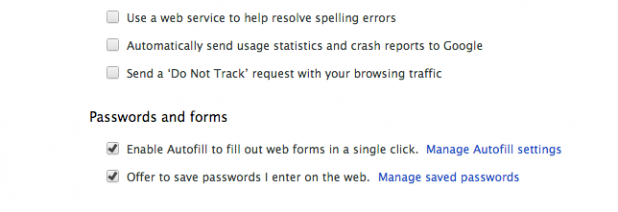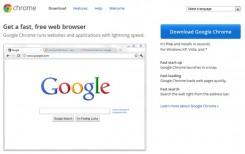 Google has implemented Do Not Track for Chrome, but it's not activated by default.[/caption] Google’s latest update to its Web browser, Chrome 23, offers a handful of useful features—but it’s the implementation of a Do Not Track feature that could draw the most attention. “This latest release also includes an option to send a “Do Not Track” request to websites and web services,” read a Nov. 6 posting on the Google Chrome Blog. “The effectiveness of such requests is dependent on how websites and services respond, so Google is working with others on a common way to respond to these requests in the future.” But Do Not Track isn’t enabled by default in the updated version of Chrome. Instead, users will need to direct their mouse to “Preferences” in the top bar, scroll down the resulting “Settings” screen to “Show advanced settings” click on that, and then scroll down again to the checkbox marked “Send a ‘Do Not Track’ request with your browsing traffic.” Chrome is actually late to the party when it comes to Do Not Track, a longtime feature of rivals Firefox and Internet Explorer. In October, Microsoft general counsel Brad Smith argued in a corporate blog posting that 75 percent of surveyed customers in the U.S. and Europe wanted Do Not Track enabled by default. Meanwhile, marketers and advertisers strenuously oppose the feature, arguing that it prevents their clients from earning revenue and collecting customer data. “There needs to be an easy and effective way for responsible advertisers and ad networks to inform consumers and obtain persistent consent for their services even if the DNT signal is turned on,” Smith suggested in his posting. “Just because the signal is turned on doesn't mean that a consumer wants no services that involve tracking. It means instead that consumers are empowered to make their own choices, including selecting services that involve tracking from advertisers and ad networks they trust.” But for some privacy-minded Web surfers, a total lack of tracking is the only viable option. In addition to Do Not Track, the new version of Chrome also streamlines the granular controls over things like pop-ups and geolocation, allowing users to tailor the browser to their exact needs. Image: Google
Google has implemented Do Not Track for Chrome, but it's not activated by default.[/caption] Google’s latest update to its Web browser, Chrome 23, offers a handful of useful features—but it’s the implementation of a Do Not Track feature that could draw the most attention. “This latest release also includes an option to send a “Do Not Track” request to websites and web services,” read a Nov. 6 posting on the Google Chrome Blog. “The effectiveness of such requests is dependent on how websites and services respond, so Google is working with others on a common way to respond to these requests in the future.” But Do Not Track isn’t enabled by default in the updated version of Chrome. Instead, users will need to direct their mouse to “Preferences” in the top bar, scroll down the resulting “Settings” screen to “Show advanced settings” click on that, and then scroll down again to the checkbox marked “Send a ‘Do Not Track’ request with your browsing traffic.” Chrome is actually late to the party when it comes to Do Not Track, a longtime feature of rivals Firefox and Internet Explorer. In October, Microsoft general counsel Brad Smith argued in a corporate blog posting that 75 percent of surveyed customers in the U.S. and Europe wanted Do Not Track enabled by default. Meanwhile, marketers and advertisers strenuously oppose the feature, arguing that it prevents their clients from earning revenue and collecting customer data. “There needs to be an easy and effective way for responsible advertisers and ad networks to inform consumers and obtain persistent consent for their services even if the DNT signal is turned on,” Smith suggested in his posting. “Just because the signal is turned on doesn't mean that a consumer wants no services that involve tracking. It means instead that consumers are empowered to make their own choices, including selecting services that involve tracking from advertisers and ad networks they trust.” But for some privacy-minded Web surfers, a total lack of tracking is the only viable option. In addition to Do Not Track, the new version of Chrome also streamlines the granular controls over things like pop-ups and geolocation, allowing users to tailor the browser to their exact needs. Image: Google Google Chrome 23 Delivers Do Not Track
[caption id="attachment_5757" align="aligncenter" width="618"]  Google has implemented Do Not Track for Chrome, but it's not activated by default.[/caption] Google’s latest update to its Web browser, Chrome 23, offers a handful of useful features—but it’s the implementation of a Do Not Track feature that could draw the most attention. “This latest release also includes an option to send a “Do Not Track” request to websites and web services,” read a Nov. 6 posting on the Google Chrome Blog. “The effectiveness of such requests is dependent on how websites and services respond, so Google is working with others on a common way to respond to these requests in the future.” But Do Not Track isn’t enabled by default in the updated version of Chrome. Instead, users will need to direct their mouse to “Preferences” in the top bar, scroll down the resulting “Settings” screen to “Show advanced settings” click on that, and then scroll down again to the checkbox marked “Send a ‘Do Not Track’ request with your browsing traffic.” Chrome is actually late to the party when it comes to Do Not Track, a longtime feature of rivals Firefox and Internet Explorer. In October, Microsoft general counsel Brad Smith argued in a corporate blog posting that 75 percent of surveyed customers in the U.S. and Europe wanted Do Not Track enabled by default. Meanwhile, marketers and advertisers strenuously oppose the feature, arguing that it prevents their clients from earning revenue and collecting customer data. “There needs to be an easy and effective way for responsible advertisers and ad networks to inform consumers and obtain persistent consent for their services even if the DNT signal is turned on,” Smith suggested in his posting. “Just because the signal is turned on doesn't mean that a consumer wants no services that involve tracking. It means instead that consumers are empowered to make their own choices, including selecting services that involve tracking from advertisers and ad networks they trust.” But for some privacy-minded Web surfers, a total lack of tracking is the only viable option. In addition to Do Not Track, the new version of Chrome also streamlines the granular controls over things like pop-ups and geolocation, allowing users to tailor the browser to their exact needs. Image: Google
Google has implemented Do Not Track for Chrome, but it's not activated by default.[/caption] Google’s latest update to its Web browser, Chrome 23, offers a handful of useful features—but it’s the implementation of a Do Not Track feature that could draw the most attention. “This latest release also includes an option to send a “Do Not Track” request to websites and web services,” read a Nov. 6 posting on the Google Chrome Blog. “The effectiveness of such requests is dependent on how websites and services respond, so Google is working with others on a common way to respond to these requests in the future.” But Do Not Track isn’t enabled by default in the updated version of Chrome. Instead, users will need to direct their mouse to “Preferences” in the top bar, scroll down the resulting “Settings” screen to “Show advanced settings” click on that, and then scroll down again to the checkbox marked “Send a ‘Do Not Track’ request with your browsing traffic.” Chrome is actually late to the party when it comes to Do Not Track, a longtime feature of rivals Firefox and Internet Explorer. In October, Microsoft general counsel Brad Smith argued in a corporate blog posting that 75 percent of surveyed customers in the U.S. and Europe wanted Do Not Track enabled by default. Meanwhile, marketers and advertisers strenuously oppose the feature, arguing that it prevents their clients from earning revenue and collecting customer data. “There needs to be an easy and effective way for responsible advertisers and ad networks to inform consumers and obtain persistent consent for their services even if the DNT signal is turned on,” Smith suggested in his posting. “Just because the signal is turned on doesn't mean that a consumer wants no services that involve tracking. It means instead that consumers are empowered to make their own choices, including selecting services that involve tracking from advertisers and ad networks they trust.” But for some privacy-minded Web surfers, a total lack of tracking is the only viable option. In addition to Do Not Track, the new version of Chrome also streamlines the granular controls over things like pop-ups and geolocation, allowing users to tailor the browser to their exact needs. Image: Google
 Google has implemented Do Not Track for Chrome, but it's not activated by default.[/caption] Google’s latest update to its Web browser, Chrome 23, offers a handful of useful features—but it’s the implementation of a Do Not Track feature that could draw the most attention. “This latest release also includes an option to send a “Do Not Track” request to websites and web services,” read a Nov. 6 posting on the Google Chrome Blog. “The effectiveness of such requests is dependent on how websites and services respond, so Google is working with others on a common way to respond to these requests in the future.” But Do Not Track isn’t enabled by default in the updated version of Chrome. Instead, users will need to direct their mouse to “Preferences” in the top bar, scroll down the resulting “Settings” screen to “Show advanced settings” click on that, and then scroll down again to the checkbox marked “Send a ‘Do Not Track’ request with your browsing traffic.” Chrome is actually late to the party when it comes to Do Not Track, a longtime feature of rivals Firefox and Internet Explorer. In October, Microsoft general counsel Brad Smith argued in a corporate blog posting that 75 percent of surveyed customers in the U.S. and Europe wanted Do Not Track enabled by default. Meanwhile, marketers and advertisers strenuously oppose the feature, arguing that it prevents their clients from earning revenue and collecting customer data. “There needs to be an easy and effective way for responsible advertisers and ad networks to inform consumers and obtain persistent consent for their services even if the DNT signal is turned on,” Smith suggested in his posting. “Just because the signal is turned on doesn't mean that a consumer wants no services that involve tracking. It means instead that consumers are empowered to make their own choices, including selecting services that involve tracking from advertisers and ad networks they trust.” But for some privacy-minded Web surfers, a total lack of tracking is the only viable option. In addition to Do Not Track, the new version of Chrome also streamlines the granular controls over things like pop-ups and geolocation, allowing users to tailor the browser to their exact needs. Image: Google
Google has implemented Do Not Track for Chrome, but it's not activated by default.[/caption] Google’s latest update to its Web browser, Chrome 23, offers a handful of useful features—but it’s the implementation of a Do Not Track feature that could draw the most attention. “This latest release also includes an option to send a “Do Not Track” request to websites and web services,” read a Nov. 6 posting on the Google Chrome Blog. “The effectiveness of such requests is dependent on how websites and services respond, so Google is working with others on a common way to respond to these requests in the future.” But Do Not Track isn’t enabled by default in the updated version of Chrome. Instead, users will need to direct their mouse to “Preferences” in the top bar, scroll down the resulting “Settings” screen to “Show advanced settings” click on that, and then scroll down again to the checkbox marked “Send a ‘Do Not Track’ request with your browsing traffic.” Chrome is actually late to the party when it comes to Do Not Track, a longtime feature of rivals Firefox and Internet Explorer. In October, Microsoft general counsel Brad Smith argued in a corporate blog posting that 75 percent of surveyed customers in the U.S. and Europe wanted Do Not Track enabled by default. Meanwhile, marketers and advertisers strenuously oppose the feature, arguing that it prevents their clients from earning revenue and collecting customer data. “There needs to be an easy and effective way for responsible advertisers and ad networks to inform consumers and obtain persistent consent for their services even if the DNT signal is turned on,” Smith suggested in his posting. “Just because the signal is turned on doesn't mean that a consumer wants no services that involve tracking. It means instead that consumers are empowered to make their own choices, including selecting services that involve tracking from advertisers and ad networks they trust.” But for some privacy-minded Web surfers, a total lack of tracking is the only viable option. In addition to Do Not Track, the new version of Chrome also streamlines the granular controls over things like pop-ups and geolocation, allowing users to tailor the browser to their exact needs. Image: Google 
